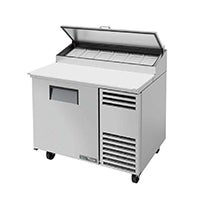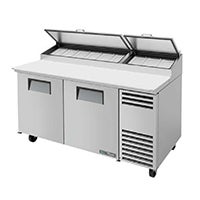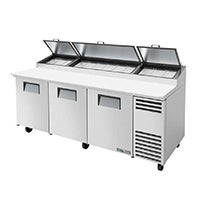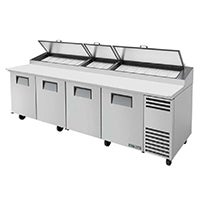Commercial Pizza Prep Tables
1 Door Pizza Prep Tables
Organize your pizza ingredients efficiently with pizza prep tables. Featuring spacious compartments, adjustable shelves, and durable construction, these tables are perfect for any pizzeria or restaurant.
2 Door Pizza Prep Tables
Keep all your ingredients close and ready to use with these 2 door pizza prep tables. Double door units provide extra storage space for more toppings, and the top is perfectly sized for preparing pizzas.
3 Door Pizza Prep Tables
Prepare more pizzas at the same time with these three door prep tables. With excellent storage space for supplies, pizza makers won't have to move around the kitchen to do their work.
4 Door Pizza Prep Tables
With 4 doors, these units provide the most space and storage for pizza toppings. Available in multiple styles and colors, they can add to your kitchen atmosphere and decor.
Streamline the assembly process and produce perfectly prepared pizzas with a commercial pizza prep table.
Any foodservice establishment that prepares pizza can improve the speed and consistency of their operation with a commercial pizza prep table. A pizza prep table, sometimes known as a makeline, has a refrigerated cabinet base, raised ingredient rail, and pizza-wide cutting board. When selecting a unit, take into account the overall width, compressor location, and number of 1/3 size food pans it will hold. The standard size pan used in ingredient rails is 12-3/4” long and 6-7/8” wide. Depths can range from two to six inches. This allows for several different toppings to be placed in the ingredient rail, and each commercial pizza prep table will typically come with a full complement of food pans. Food pan divider bars are also available if you need to use smaller size pans.
Be sure to check the overall width of the commercial pizza prep table to ensure it will properly fit into the space you have available. Also, the compressor unit is either located on one of the sides or in the back of the table. It is important to make sure that the compressor air vents are given sufficient clearance to allow for proper air flow. If the vents become blocked, the compressor motor can burn out, resulting in lost product and revenue.
Frequently Asked Questions About Commercial Pizza Prep Tables
What's the difference between a commercial pizza prep table and a sandwich prep table?
Commercial pizza prep tables are designed with a wider cutting board than sandwich or salad prep tables, since the pizzas that will be assembled have a greater width than typical sandwiches. Additionally, pizza prep tables have a raised rail design to ensure that unwanted toppings aren't accidentally dropped onto food items as they're prepped. Pizza prep tables typically accommodate 1/3 sized food pans and are equipped to cool a much denser and larger amount of food products. Sandwich prep tables generally are designed to hold 1/6 sized food pans and hold veggie toppings or condiments that have a lower density than the cheeses and meats held in pizza prep tables.
What kind of refrigeration is best?
For commercial pizza prep tables, there are a few standard cooling methods used to properly refrigerate ingredients. Each option has its own benefits whether it's initial cost, efficiency, or effectiveness.
- Air cooled - This is one of the most common methods of refrigeration since it's simple to use and is generally low-maintenance. Air cooling can be less effective than other methods because it relies heavily on moving cooled air throughout the unit. When the top lid to the rail is left open for long periods of time, air is allowed to escape the unit, forcing the refrigeration system to work harder to maintain food-safe temperatures.
- Cold wall - Some units use forced air cooling for the refrigerated storage space, and a cold wall system to cool the pans of ingredients in the rail. Cold wall cooling uses refrigerant lines and conductive aluminum plates in the walls of the refrigerated rail to maintain temperatures in the rail. Since the rail temperature in these units is controlled independently from the rest of the unit, the rail can be shut off and defrosted at night for more efficient cooling the next day.
- Glycol - This type of cooling system is similar to cold wall cooling, but instead of using aluminum plates, this system runs cold fluid through the divider rails. Refrigerant and glycol are run through separate sides of an evaporator plate to transfer temperature from one to the other. The chilled glycol is then pumped into the rail walls and effectively chills food pans. Glycol is a specific type of liquid that has been altered to ensure it won't freeze with the cold temperatures. This type of system is beneficial because it doesn't need to defrost, and also since no fans are used, there is no need for air vents around the pans. Commercial pizza prep tables that use this cooling system can accommodate deeper food pans as well since there's no need for a recess to maintain cold food temperatures.
What pan capacity should I choose?
Pan configurations are entirely dependent on the volume of product your restaurant moves, as well as the number of toppings you plan to incorporate into your menu. For smaller pizzerias with a few signature pizzas, a 6 or 8 pan pizza prep table may be the perfect fit. If space and budget allows, you may decide to purchase a larger unit with the ability to hold more pans. Consider the variety of toppings your pizzeria or restaurant plans to offer when choosing the right commercial pizza prep table for your business.





Login and Registration Form